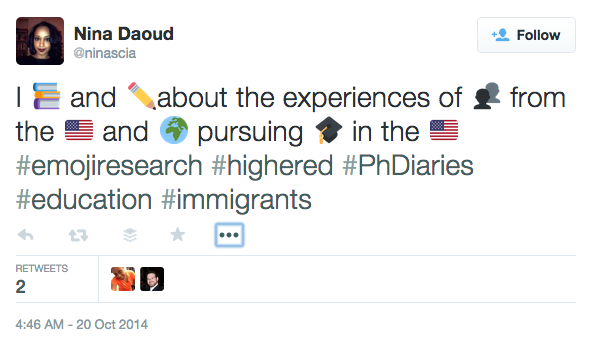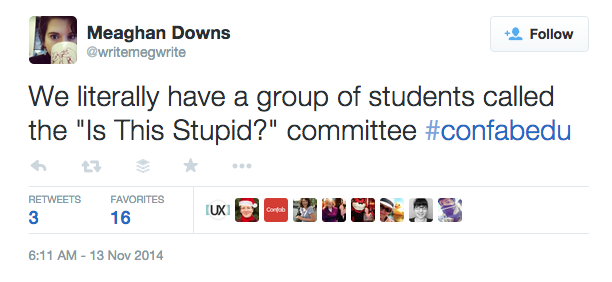
![]()
![]()
![]()
Or like this:
(•_•)
<) )╯College
/ \
\(•_•)
( (> is finally
/ \
(•_•)
<) )> over.
/ \
Or perhaps they would feel more like this:

Why are we talking about GIFs, emoji, and ASCII art in a space where we typically discuss CMS workflows and editorial calendars. Because these are becoming increasingly prominent forms of communication that convey meaning by enhancing or even replacing text. They are also prevalent within the language of social communication, by virtue of their ability to represent multiple words’ worth of reaction or explanation in a short visual burst.
Just as with any content, appropriate usage is key. So, to take a slightly lighter turn, we decided to look at these fun formats a little more closely.
A Compressed Image File is Worth a Thousand Words: GIFs
First up, let’s talk GIFs. GIFs (graphics interchange format), first created in 1987, are a file format created by early internet provider Compuserve (remember Compuserve?) that supports animation.
In recent years, as advances in software have made them easier to create, GIFs have blown up in popularity as a way to create a currency of social content around pop culture, often achieving meme status. In a 2013 explainer about the popularity of GIFs, The New York Times called them a “visual way to drive home a written point.” Reddit defines the ever-popular “reaction gif” as “a physical or emotional response that is captured in a gif which you can link in response to someone or something on the Internet.”
But at its heart, the GIF presents an easy way to add an engaging animated element to our content at low cost. In higher ed, GIFs have be used a few ways:
- To depict scientific phenomena (Harvard University)
- To share and react to student content (Ithaca College)
- In lieu of static imagery (Oberlin Colege)
- To reinforce a point or a call to action. (Earlier this year, FAFSA experienced both the upside and downside of sharing social visual content for this purpose.)
The challenge with GIFs, of course, is that since they are an image format, their content is not intrinsically searchable or accessible by the visually impaired. Luckily, there are GIF-specific search engines out there.
Find Your Emoji Mojo
If you’re looking to communicate visually without using image files, emoji and ASCII art may be more your style.
Emoji, which roughly translates to the Japanese for “picture characters,” are colorful pictographs representing a range of feelings, items, and phenomena. (You can even track real-time emoji use on Twitter.) Created in 1998, emoji initially grew in popularity because they allowed for colorful, visual communication without occupying significant bandwidth. They also function as a sort of lingua franca, employing pop culture agnostic visual imagery that speakers of most any language can comprehend.
The great thing about emoji is that, by virtue of being text characters (using the Unicode character set) and not images, emoji are fully accessible. That means they offer a great way to communicate visually without worrying about the usual limitations of JPGs, GIFs, and other image file formats. (The July 2014 episode of the Access Ninja podcast talks about emoji and accessibility in greater depth.)
However, it’s important to note that emoji sets vary between iOS, Android, and Windows platforms, which means one iPhone user’s flamenco dancer is another Android user’s disco dancer, which could potentially change the intended meaning of your message. Emojipedia is a great resource for seeing which emoji are featured on which platforms.
Emojis can be busted out on special occasions or integrated into your everyday communications. Here are some examples:
- Earlier this fall, several faculty members tweeted about their research using emojis, with the hashtag #emojiresearch.
- During the World Cup, Twitter rolled out emoji “hashflags” for the various countries in competition, which displayed when users tweeted the three-letter country code for their team. Twitter also employed hashflags for the Muslim holidays of Eid and Ramadan.
- Tufts University does a great job of incorporating emoji into its tweets and Instagram photos.
ASCII Me Anything
Last but not least, we have ASCII. ASCII (American Standard Code for Information Interchange) is a numerical representation of a text character designed to be comprehended by computers. (Unicode is actually a subset of ASCII.)
ASCII has been around since the 1960s, and there is a great tradition dating back long before the World Wide Web of creating art using ASCII characters. Today, for many of the same reasons as emoji, ASCII art has experienced a resurgence — including on Twitter, where it takes the form of emoticon memes like Sign Bunny or the stick figure ASCII art used at the beginning of this post.
| ̄ ̄ ̄ ̄ ̄ ̄ |
| FEZZES |
| ARE |
| COOL |
| _______|
(\__/) ||
(•ㅅ•) ||
/ づ
The Daily Dot offers a great glossary deciphering various ASCII emoticons. One of the most popular lately is “Shruggie,” or ¯\_(ツ)_/¯, which Reuters editor Share Ferro describes as “the default Internet feeling.”
While the text characters of ASCII art are accessible via screen readers and similar technology, the visual arrangement that makes the artwork notable does not carry over.
Making Good Use of GIFs, ASCII, and Emoji
As some of the preceding examples have shown, higher ed can use these popular visual forms to great effect. But there are a few considerations to be mindful of.
Don’t try too hard to be funny
As Tracy Playle discussed at Confab Higher Ed this year, humor can be highly effective but is difficult to do well. A GIF that doesn’t nail it, or gratuitous or inappropriate emoji, will draw the wrong kind of laughs.
Don’t try too hard to be cool
Don’t force the use of one of these communication styles if it doesn’t feel right or doesn’t make sense. No one will think less of you for never using GIFs, but they might if you use them poorly. Let common sense prevail.
“Is this stupid?”
One of my favorite little takeaways from Confab Higher Ed 2014:
A group like this could come in handy if you’re looking to update your communications style.
Be mindful of rights and licensing
If you’re creating a GIF, make sure you won’t get in trouble for the imagery you use if you don’t own it.
Be appropriate
As with all content, consider voice and tone, and consider your audience. Is a GIF out of place here? Does using emoji or ASCII art enhance or detract from what I am trying to say? What tone does it convey? Will the people reading this get the point? All of these formats are just new kinds of words, in a way, so let’s use them with the same care and consideration.
Also, consider the context. “Shruggie,” for instance, is not appropriate for every situation where there’s a question or some uncertainty. It has acquired a cultural meaning that should not be misappropriated.
Clarity Before Coolness
As with any new, shiny object out there, it can be tempting to dive in without thinking too hard about it. After all, GIFs and emoji can be uniquely effective, and they’re incredibly pervasive across social media at the moment. Finally, our chance to be cool!
But alas, it’s not our job to be cool. Our job is to communicate. Sometimes, the two overlap, but we should never let the former trump the latter. These formats have a history and context that it is important to understand in order to use appropriately. If we know our stuff and keep our eyes peeled for the right opportunity, we might just pull it off.
How are you using these forms of visual communication at your institution? What other considerations should we be taking into account?




We face this issue a lot with our digital signage clients (http://www.fourwindsinteractive.com). They often want to use gifs and other media that they do not own. While it is not our job to tell them what they can/can’t post or police what they do, there is an implication here and it is currently thought of as an ethical gray area. Of course, it is an easy solution to just take it down when/if someone complains, but some companies build a lot of effort and collateral around things they don’t own, which equates to lost time and money.